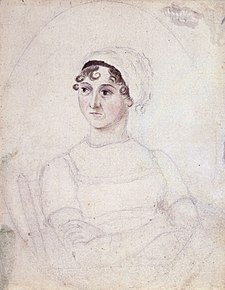Our website is made possible by displaying online advertisements to our visitors.
Please consider supporting us by disabling your ad blocker.
Jane Austen
Jane Austen | |
|---|---|
 Portrait of Jane Austen, drawn by her sister Cassandra (c. 1810) | |
| Born | 16 December 1775 Steventon Rectory, Hampshire, England |
| Died | 18 July 1817 (aged 41) Winchester, Hampshire, England |
| Resting place | Winchester Cathedral, Hampshire, England |
| Period | 1787 to 1809–11 |
| Genre | Romance |
| Signature | |
Jane Austen (16 December 1775 – 18 July 1817) was an English novelist. She wrote many books of romantic fiction about the gentry. Her works made her one of the most famous and beloved writers in English literature.[1] She is one of the great masters of the English novel.
Austen's works criticized sentimental novels in the late 18th century, and are part of the change to nineteenth-century realism.[2] She wrote about typical people in everyday life. This gave the English novel its first distinctly modern character.[3] Austen's stories are often comic,[4] but they also show how women depended on marriage for social standing and economic security.[5] Her works are also about moral problems.[6]
Jane Austen was born on 16 December 1775 at Steventon, near Basingstoke.[7] Educated mostly by her father and older brothers, and also by her own reading, she lived with her family at Steventon. They moved to Bath when her father retired in 1801. After he died in 1805, she moved around with her mother. In 1809, they settled in Chawton, near Alton, Hampshire. In May 1817 she moved to Winchester to be near her doctor. She died there on 18 July 1817.
Jane Austen was very modest about her own genius.[7] She once famously described her work as "the little bit (two Inches wide) of Ivory, on which I work with so fine a brush, as produces little effect after much labor".[7] When she was a girl she wrote stories. Her works were printed only after much revision. Only four of her novels were printed while she was alive. They were Sense and Sensibility (1811), Pride and Prejudice (1813), Mansfield Park (1814) and Emma (1815). Two other novels, Northanger Abbey and Persuasion, were printed in 1817 with a biographical notice by her brother, Henry Austen. Persuasion was written shortly before her death. She also wrote two earlier works, Lady Susan, and an unfinished novel, The Watsons. She had been working on a new novel, Sanditon, but she died before she could finish it. She is now a well known great writer.
- ↑ Southam, "Criticism, 1870–1940", The Jane Austen Companion, 102.
- ↑ Litz, 3–14; Grundy, "Jane Austen and Literary Traditions", The Cambridge Companion to Jane Austen, 192-93; Waldron, "Critical Responses, Early", Jane Austen in Context, p. 83, 89–90; Duffy, "Criticism, 1814–1870", The Jane Austen Companion, 93–94.
- ↑ "Jane Austen (English novelist) – Britannica Online Encyclopedia". britannica.com. Retrieved 31 May 2010.
- ↑ Litz, 142.
- ↑ MacDonagh, 66–75; Collins, 160–161.
- ↑ Honan, 124-27; Trott, "Critical Responses, 1830–1970", Jane Austen in Context, 92.
- ↑ 7.0 7.1 7.2 Jones, Vivien (2003) [1996]. Introduction to Pride and Prejudice. 80 Strand, London, WC2R ORL, England: Penguin Classics. ISBN 0-141-43951-3.
{{cite book}}: CS1 maint: location (link)
Previous Page Next Page


